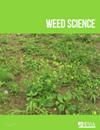刺青的物候、生长和种子产量对其出现时间和种群的响应
IF 2.1
2区 农林科学
Q2 AGRONOMY
引用次数: 0
摘要
【摘要】丛林草[Echinochloa colona (L.)]链接。是澳大利亚夏季种植系统中最重要的杂草物种。虽然它主要是春夏季出现的杂草物种,但实地观察表明,大肠杆菌正在扩大其季节性。在昆士兰大学的农场进行了一项普通的花园实验,以研究种植日期对8个大肠杆菌种群的物候、生长和繁殖力的影响。在2019年至2020年和2020年至2021年期间,每隔第二个月播种一次所有种群。在11月或1月种植时,棘藻菌落出芽时间最短(4 ~ 6 d)。然而,11月群体花了最长的生长度数来表现出穗状花序。在这两年中,种群在高度和叶片、分蘖、穗和种子产量上对播种时间的反应不同。11月种植的植物生物量显著增加(123 ~ 147 g),其次是1月和9月的种植。3月种植的生物量最低。第一年,3月份播种的种子数量最少(3500粒/株);然而,在第二年,3月和7月的播种产生了相同数量的种子。第一年,11月播种时种子产量最高(51000粒/株);然而,一些种群也为一月份的播种生产了相同数量的种子。第二年,与其他播种日期相比,1月份播种的种子产量显著增加(每株111,000粒)。地上生物量与大肠杆菌种子产量呈显著正相关。这项研究揭示了大肠杆菌种群之间的差异,并建议尽管必须更加重视控制春夏发芽的植物,但需要全年推广管理措施,以控制澳大利亚东南部的大肠杆菌。本文章由计算机程序翻译,如有差异,请以英文原文为准。
Phenology, growth, and seed production of junglerice (Echinochloa colona) in response to its emergence time and populations
Abstract Junglerice [Echinochloa colona (L.) Link.] is the most important grass weed species in Australian summer cropping systems. Although it is mainly a spring- and summer-emerging weed species, field observations suggest that E. colona is expanding its seasonality. A common garden experiment was conducted at the University of Queensland farm to examine the effect of planting dates on phenology, growth, and fecundity of eight populations of E. colona. All populations were planted every second month from September to July in 2019 to 2020 and 2020 to 2021. Echinochloa colona took the shortest time (4 to 6 d) to emerge when planted in November or January. However, the November population took the longest number of growing degree days to exhibit panicle emergence. In both years, populations differed in height and leaf, tiller, panicle, and seed production in response to planting times. Plants produced significantly greater biomass for the November planting (123 to 147 g plant–1) followed by the January planting and then the September planting. The March planting produced the lowest biomass. In the first year, the lowest number of seeds (3,500 seeds plant–1) was produced by the March planting; however, in the second year, similar numbers of seeds were produced by the March and July plantings. In the first year, seed production (51,000 seeds plant–1) was greatest for the November planting; however, some populations also produced a similar number of seeds for the January planting. In the second year, significantly greater seed production (111,000 seeds plant–1) was observed for the January planting compared with other planting dates. The aboveground biomass and seed production of E. colona were positively correlated. This study reveals variations among E. colona populations and suggests that although greater emphasis must be placed on controlling spring- and summer-emerging plants, management practices need to be extended throughout the year to control E. colona in southeastern Australia.
求助全文
通过发布文献求助,成功后即可免费获取论文全文。
去求助
来源期刊

Weed Science
农林科学-农艺学
CiteScore
4.60
自引率
12.00%
发文量
64
审稿时长
12-24 weeks
期刊介绍:
Weed Science publishes original research and scholarship in the form of peer-reviewed articles focused on fundamental research directly related to all aspects of weed science in agricultural systems. Topics for Weed Science include:
- the biology and ecology of weeds in agricultural, forestry, aquatic, turf, recreational, rights-of-way and other settings, genetics of weeds
- herbicide resistance, chemistry, biochemistry, physiology and molecular action of herbicides and plant growth regulators used to manage undesirable vegetation
- ecology of cropping and other agricultural systems as they relate to weed management
- biological and ecological aspects of weed control tools including biological agents, and herbicide resistant crops
- effect of weed management on soil, air and water.
 求助内容:
求助内容: 应助结果提醒方式:
应助结果提醒方式:


